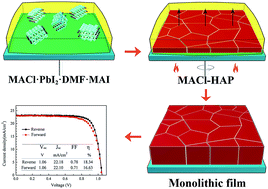Monolithic MAPbI3 films for high-efficiency solar cells via coordination and a heat assisted process†
Abstract
The monolithic perovskite films with a single crystal cross profile are considered to be the ideal active layer for high efficiency perovskite solar cells (PSCs) owing to the minimization of defects and the maximization of charge carrier mobility. To date, how to prepare a high-quality monolithic perovskite film is still a challenge for PSCs. Here, we demonstrated a combined method via CH3NH3Cl (MACl) coordination and a heat assisted process (HAP) to grow a compact monolithic CH3NH3PbI3 (MAPbI3) film with an average grain size of 3.6 μm. The ordered intermediate phase framework of MAPbIxCly grew up from the bottom to the top on the heated substrate, avoiding the grain boundaries and pin-holes in the cross profile. According to the space charge limited current (SCLC), the trap density in the monolithic film was nearly an order of magnitude lower than that of the control samples, while the charge carrier mobility increased to 22.74 cm2 V−1 S−1, approaching that of the MAPbI3 single crystal. As a result, the power conversion efficiency (PCE) of the PSCs is increased from 13.26% to 18.34%. These results shed light on the preparation of high quality monolithic MAPbI3 films via retarding crystallization (MACl additive) and increasing the nucleation rate (HAP).



 Please wait while we load your content...
Please wait while we load your content...